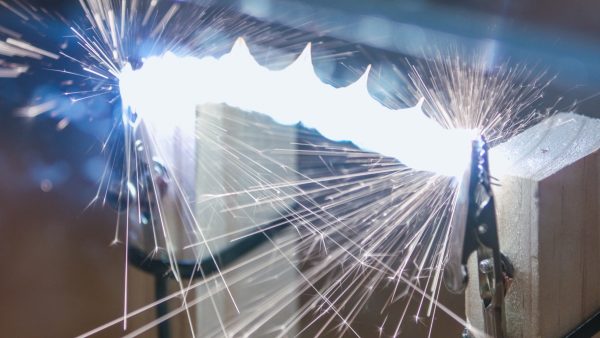Batteries Definition
Batteries convert chemical energy into electrical energy to power devices. For example, they can be the source of energy in an electrical circuit.
View Lesson on Electricity & Circuits
Become a member to get full access to our entire library of learning videos, reading material, quiz games, simple DIY activities & more.
Become a member to get full access to our entire library of learning videos, quiz games, & more.
Plans & Pricingto watch this full video.

Access All Videos
and Lessons, No Limits.
Access All Videos

No credit card required,
takes 7 sec to signup.
No card required

Ready-to-go lessons
that save you time.
Ready-to-go lessons
If you are on a school computer or network, ask your tech person to whitelist these URLs:
*.wistia.com, fast.wistia.com, fast.wistia.net, embedwistia-a.akamaihd.net
Sometimes a simple refresh solves this issue. If you need further help, contact us.
Electricity & Circuits
Fun Facts
- You can make a battery out of coins to power an LED!
- Volts measure a battery's potential energy; higher volts mean more energy.
- You could use a higher or lower volt battery to control the spin of a motor.
Why Do We Need To Know About Batteries
Learning about batteries helps us understand how they power things like toys. Batteries are important because they make a lot of our everyday gadgets work, from electric cars to our smartphones.
Batteries are also key in medical tools like artificial arms and in creating new computer technology. This shows how batteries are not just useful for powering things we use every day but also play a big part in creating new jobs and tech advancements in many areas.
Frequently Asked Questions
Check out the Full Lesson on Electricity & Circuits
In this lesson, we learn that:
- Electricity is the flow of electrical energy from one place to another.
- Electricity flows through conductors, but it cannot flow through insulators.
- A closed circuit is needed for electricity to flow and power our electronics.
Related Topics
- Adaptation Definition
- Batteries Definition
- Body Fossils Definition
- Cast Fossils Definition
- Chemical Change Definition
- Circuit Definition
- Comparative Anatomy Definition
- Conductor Definition
- Definition Of Nutrients
- Digestive System Definition
- Earth’s Axis Definition
- Electricity Definition
- Energy Definition
- Exoskeleton Definition
- Food Web Definition
- Heating And Cooling Definition
- Insulator Definition
- Keystone Species Definition
- Law Of Conservation Of Matter Definition
- Liquid Definition
- Magnetism Definition
- Mass Definition
- Matter Definition
- Motion Definition
- Opposable Thumb Definition
- Parasitism Definition
- Partial Eclipse Definition
- Particle Model Of Matter Definition
- Pattern Definition
- Period Definition
- Phases Of The Moon Definition
- Plant Growth Definition
- Pollen Definition
- Prey Definition
- Pulley Definition
- Scientific Name Definition
- Scientist Definition
- Seismologist Definition
- Solar Eclipse Definition
- Solar System Definition
- Species Definition
- Symbiosis Definition
- Tectonic Plates Definition
- Translucent Definition
- Volts Definition
- Water Definition
- Wavelength Definition
- Weather Front Definition
Start a Free Trial Today. Get a $5 Amazon Gift Card!
Teachers! Start a free trial & we'll send your gift card within 1 day. Only cards left. Try it now.
Select Grade
Select Subject
This email is associated with a Science Kit subscription. Kit subscriptions are managed on this separate page: Manage Subscription

-
Download InvoiceScience & Math$/yr
-
Download InvoiceScience Only$/yr

access all lessons
• No credit card required •
"My students loved the videos. I started the video subscription in May and used them as a review before the state test, which I know contributed to 100% of my class passing the state test."
Rhonda Fox 4th Grade Teacher, Ocala, Florida
Use Generation Genius in Your School
Access all lessons free for 30 days.
"My students loved the videos. I started the video subscription in May and used them as a review before the state test, which I know contributed to 100% of my class passing the state test."
Rhonda Fox 4th Grade Teacher, Ocala, Florida
• No credit card required •
Already a member? Sign In
* no credit card required *

* no credit card required *
* no credit card required *


to Discover the Benefits of Generation Genius
Learn How to Save for Your School & District!

no credit card required
Skip, I will use a 3 day free trial
Enjoy your free 30 days trial
-
Unlimited access to our full library
of videos & lessons for grades K-5. -
You won’t be billed unless you keep your
account open past your 14-day free trial. -
You can cancel anytime in 1 click on the
manage account page or by emailing us.
-
Unlimited access to our full library of videos & lessons for grades K-5.
-
You won't be billed unless you keep your account open past 14 days.
-
You can cancel anytime in 1-click on the manage account page.
Cancel anytime in 1-click on the manage account page before the trial ends and you won't be charged.
Otherwise you will pay just $10 CAD/month for the service as long as your account is open.
Cancel anytime on the manage account page in 1-click and you won't be charged.
Otherwise you will pay $10 CAD/month for the service as long as your account is open.
We just sent you a confirmation email. Enjoy!
DoneWe use cookies to make your experience with this site better. By using this site you agree to our use of cookies. Click "Decline" to delete and block any non-essential cookies for this site on this specific property, device, and browser. Please read our privacy policy for more information on the cookies we use.Learn More
We use cookies to improve your experience. By using this site, you agree to our use of cookies. Click "Decline" to block non-essential cookies. See our privacy policy for details.Learn More




























































































































